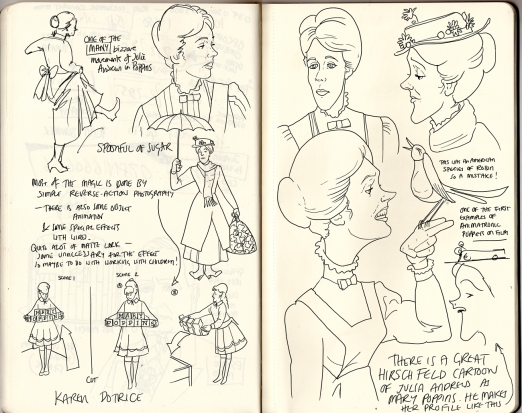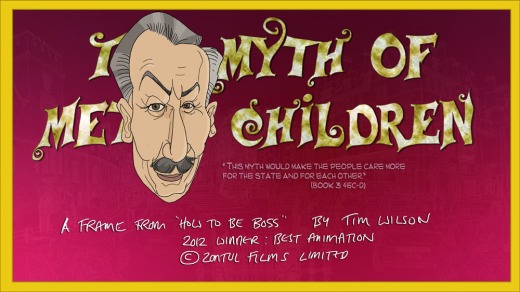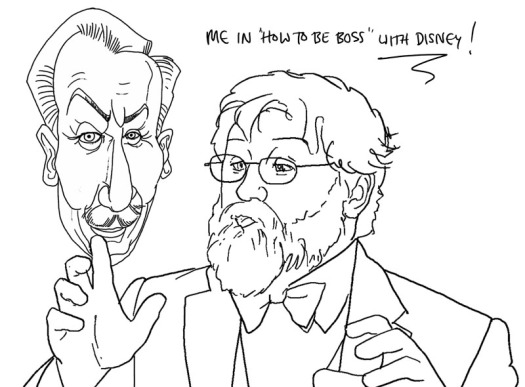The Dark Prince:
There was a dark side to Disney. There! I have said it. It is hard to imagine when the charm of the man exudes from “Saving Mr Banks” and when every outing of a Disney cartoon reaffirms his near-Divinity, lying just south of Father Christmas and in the company of St Francis of Assisi, the Doctor Doolittle of Paradise. To add to the sense of triumphant hagiography, Disney acquired his own Mother Goddess in the form of Julie Andrews, descending from a cloud to right the wrongs in London and returning there when things, to the echoing strains of that Sherman Brothers’ hymn “Let’s go fly a kite”, are just about right. To cement the deal of course, her name was Mary.
Later on, Mary affirmed her Catholicism, attended a convent and looked after a large family of Austrian refugees. Disney, meanwhile, died and was survived by his wholesome legacy, a global institution to rival the Vatican, and his surrogate son, Mickey Mouse who never aged and, though temped to perform magic to music in “Fantasia”, never did any real wrong. All this looks suspiciously religious!
This picture is from “How to be Boss” which you can see here on Youtube:
Disney and the Nine old men:
But the dark myths about Disney lurk in the recesses of the Internet and in glorious books like “King Rat” and Marc Eliot’s “Hollywood’s dark prince”. The sins seem to fall into three areas- the first is his alleged anti-semitism, the second, his labour relations and his record as an employer and the third is his interest in surviving death. As a film maker, and moreover, an animator, the way Disney managed his empire is of great significance to me. If he made mistakes, then I would want to avoid them and if he did things right that it makes sense to emulate him. For the most part, I resent the endless stories in what are marketed as serious books about animation going on endlessly about who put the cat in the cupboard. When it comes to animation, it is important to learn the trade from the masters- how to convince an audience that a 2d drawing is alive and more than that, has feelings. So I have little interest in the private lives of the 9 old men. I met one of them some years ago- frankly, I have no recollection which one it was, though I think maybe Marc Davis. He talked endlessly about the Disney theme parks and pooh-poohed the use of cinemascope in “Sleeping Beauty”.
However, the life of Disney represents something different because it was Disney who held together, developed and maybe exploited his various artists to such remarkable and lasting effect. Unlike Richard Williams, Disney was no great Draughtsman, nor indeed a gifted animator, but he had an instinct for story-telling and was clearly ready to listen to and implement advice about marketing. It is the marketing that has made the movies from the appearance of Mickey mouse memorabilia within a year of the release of “Steamboat Willie” to all the party frocks for little girls that accompanied the release of “Frozen”. I remember having a much-loved carpet of “Mary Poppins”. A carpet, note and not a carpet-bag.It was pink, peopled with penguins and a tortoise or two while in the centre, Mary Poppins herself floated in serenity. I also had jigsaw puzzles. Indeed, my father was so frustrated by my devotion to Mary that he twice fired his shotgun out of the bedroom window claiming to have “got the damn woman”. Somehow, I knew that my father, despite the tweed suit, was not quite the crack-shot he claimed to be, and that Mary Poppins would survive as indeed she did. Like the birds, she may have lost a few feathers, but “spit spot” on she flew.
Uncle walt and the myths
Today, people want to believe the worst of their heroes. American articles have appeared in recent years suggesting that Disney was a hard-drinking drug user, an FBI stouge or spy, and even a secret Nazi attending meetings of the American Nazi groups. His public image as attested in “Saving Mr Banks” was avuncular. “Call me Uncle Walt!” Karen Dotrice, the girl from Guernsey who played Jane in “Mary Poppins” certainly did just this and made three films for her beloved uncle. There are endless postings on the internet about what appear to be sexual imagery in the films of the late 80’s renaissance: the 2 frames of nudity in “the Rescuers”, some (intentionally) suggestive stuff in “Roger Rabbit”, the phallic tower on the cover of “Little Mermaid” and “Aladdin”, the Bishop’s apparent arousal, the word sex in the stars in “Lion King” and the suggestion that the relationship between Scar and his brother hints that Jesus and satan were siblings; There is generally an innocent explanation. The animator who drew the Bishop in “the Little Mermaid”, Tom Sito, says that what appears to be naughty is in fact the cleric’s knee: “He’s standing on a box that his long robes cover.” There were complaints that the opening verse in the first song of “Aladdin” was racist and that the “Pocahontas” film covered up her subsequent conversion to Christianity. Perhaps the most impressive of these claims, and one that might stick to Disney himself were it credible, is that in 1937, Donald Duck is supposed to have said “Fuck you” to a clock spring that simply would not stay in place. Frankly, it is possible to read any interpretation into some of the duck rants and I doubt that this expression would have been that common in the mid 30s. The film is on Youtube, so listen to it: I could not locate these words but there was an AFA condemnation registered in 1996: “Disney blasted for using the F word in Donald Duck cartoon”!
The Disney in “Mr Banks” seems to know he is not perfect. When he stubs out a cigarette, he says, “I’d hate to set a bad example for the kids.”
is their any evidence?
Many of the spurious tales come from the Eliot book, “Hollywood’s dark prince”, especially the idea that Disney was a spy, flying to New York to attend left-wing meetings and later to file reports for the FBI. Much of Eliot’s material comes from a disgruntled Disney employee who was barely at the studio for 6 months. Indeed, much of the bile in general comes from the poor handling of a strike in 1941 that lingered on for 4 months. Disney was convinced that communist agents had stirred up trouble with the Screen Cartoonists’ guild. Disney detested the strikers and they him. It is hardly surprising that rumours began. Certainly it is true that Disney was registered as an FBI SAC Contact in 1955 and I suppose in the climate the allegations that he shopped suspected communists to the government may well be true; he was called to testify in 1947 and his testimony is fairly damning but naive: “Well, I think Sorrell is sure tied up with them. If he isn’t a Communist, he sure should be one.” His testimony certainly damaged the careers of some people in the industry and I think he must be held responsible for some of the blacklisting that went on. That he joined an organisation called “the Motion Picture Alliance for the Preservation of American Ideals” is quite true and this had explicit aims of getting rid of Hollywood’s communists. Some of the members were known anti-semites: Jack warner and Louis B Mayer did not join the organisation because of the anti-semitic bias, but that does not prove Disney was an anti-semite (despite the stereotypes in “three Little Pigs” and “the Opry House”). There seems little truth, equally, in claims that he was a Nazi and some of the war propaganda suggests he was firmly against Hitler though he certainly is recorded by Art Babbitt as meeting Leni Reifenstahl in 1938 She claimed Disney“told her he admired her work”; if he was a racist then he was a man of his time, but any charge that he was an anti-semite seems to be confounded hy his employment of people like Maurice Rapf, who also had a left-wing, probably communist background.
A serious issue
What is perhaps wrong and deeply so is that Disney implied that his workers would get a bonus for what they did on the early features and this never happened. Also, Disney hired women only to ink and paint the animation cels. He paid them a pittance. I have done this work and it is soul-destroying. Any corrections that the painter makes to sloppy animation go unrewarded and unrecognised. But such corrections are essential and part of the expected vigilance of the painter. The detail and discipline of the cel painting during the early Disney period- indeed, until “Sleeping Beauty” is astonishing.
Cryrogenics
There is one myth I have not touched on and that is Disney’s immortality: was he frozen? It always seemed a bit creepy. Would this have been done some time after his death or at some point when his body was still warm? The creepiness continues with stories that it was just his head that was frozen and that his body is kept somewhere under Disneyland for resurrection…It all sounds a bit biblical. But I believe his ashes are buried in Forest lawn memorial park in Glendale and that the story is false and probably dependent on a biography by Robert Mosley in 1986. But there was an initial report about freezing in a French Magazine, “Ici Paris” in 1969.
What can be stated with confidence is that there was secrecy about Disney’s final illness and that his brother was encouraged by Walt to keep everything quiet. This probably explains why the announcement of the death was delayed. Also, after having serious cancer surgery and the removal of his left lung, Disney returned to work in his office for about 10 days prior to his death. His daughter Diane is supposed to have said that her father hated funerals and insisted, “When I’m dead I don’t want a funeral. I want people to remember me alive”. That is a statement that alone might well have given rise to all the cryronic stories. It just depends how you interpret the words!
There are some Disney pluses, again not all of them belong to the man, but they certainly seem to be in line with his legacy. Top of the list must be the continued brilliance of the marketing department. Then comes the equal opportunities employment of gay people, provision for their partners and the recognition that Michael Eisner notes that “40% of Disney’s 63000 employees are homosexual”. That seems to redress the balance in a way.




great points altogether, you simply received a brand new reader.
What would you recommend in regards to your publish that you just made
a few days in the past? Any sure?
Did disney have a dark side. damn right he did!
trendy, and furthermore good, in addition to being graceful. I would’ve awarded china the top review.
Veery good article! We will be linking to this
particularly great article on our website. Keep up the great writing.